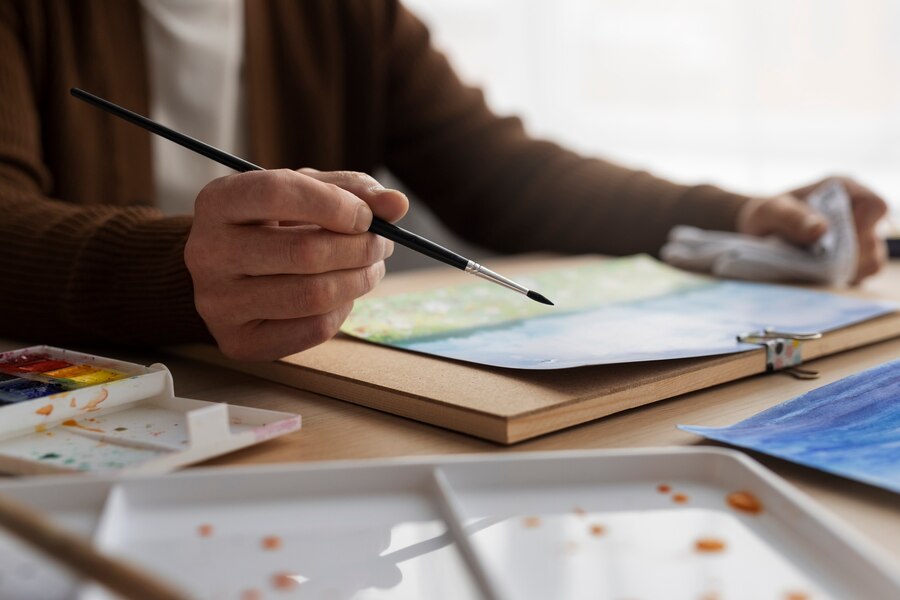
Are you eager to dive into the world of watercolor painting but don’t know where to start? Watercolor is one of the most rewarding yet initially challenging art forms. However, with proper guidance and practice, you’ll create beautiful pieces in no time. This guide walks you through essential watercolor techniques with beginner-friendly tutorials to build your confidence and skills.
Gathering Your Basic Watercolor Supplies
Before picking up a brush, you’ll need the right materials. Start with student-grade supplies as you learn the basics. First, acquire a simple watercolor set with primary colors. Next, purchase two or three brushes in different sizes – a round #6, a flat ½ inch, and a fine detail brush. Then, select 140lb cold-pressed watercolor paper for the best results. Finally, grab a palette, water container, and paper towels.
Understanding Watercolor Fundamentals
Watercolor behaves differently from other mediums. Initially, practice creating a value scale with a single color. Then, experiment with wet-on-dry and wet-on-wet techniques. Moreover, try creating gradients by gradually adding water to dilute the pigment. Subsequently, practice layering colors once each layer dries completely. Additionally, learn to control water content on your brush for different effects.
Simple Wash Techniques for Beginners
Washes form the foundation of watercolor painting. First, start with a flat wash by loading your brush generously. Then, paint horizontal strokes from top to bottom consistently. Meanwhile, for graded washes, add more water as you move down the page. Furthermore, practice circular washes for sunset or floral backgrounds. Finally, let each wash dry thoroughly before adding new elements.
Creating Your First Watercolor Landscape
Landscapes are perfect for beginners. Initially, sketch a simple horizon line very lightly. Next, paint the sky with a blue wash, fading toward the horizon. Subsequently, add distant hills with diluted color. Then, paint closer elements like trees with slightly stronger pigment. Finally, add details once the main elements dry. Additionally, use a dry brush technique for texture in foreground elements.
Mastering Simple Floral Watercolors
Flowers make excellent beginner subjects. First, begin with loose, abstract florals rather than detailed botanical illustrations. Next, practice basic petal shapes with single brushstrokes. Then, experiment with dropping colors into wet areas for natural blending. Moreover, use negative painting to define white flowers against colorful backgrounds. Finally, add stems and leaves using a lighter touch.
Exploring Watercolor Texture Techniques
Textures add interest to your paintings. First, try sprinkling salt on wet washes for crystalline patterns. Then, experiment with plastic wrap to create organic textures. Meanwhile, practice splattering for random dots using a toothbrush. Furthermore, use rubbing alcohol with a cotton swab for unique bubble effects. Finally, combine different textures in a sampler to reference for future projects.
Troubleshooting Common Beginner Challenges
Every new artist faces obstacles. First, prevent paper buckling by taping edges to a board before painting. Next, fix unwanted bleeds by carefully blotting with a paper towel. Then, rescue muddy colors by letting them dry before adding new layers. Moreover, avoid overworking by planning ahead and working in stages. Finally, embrace happy accidents as learning opportunities.
Daily Practice Projects to Build Your Skills
Consistent practice leads to improvement. Start with a 30-day challenge of small daily paintings. Additionally, try copying simple tutorial videos at half-speed. Then, photograph everyday objects and paint simplified versions. Furthermore, practice mixing the same color in different ways. Meanwhile, keep a watercolor journal to track your progress over time.
Remember, watercolor mastery comes through practice and patience. Focus on enjoying the process rather than creating perfect paintings. Through these step-by-step tutorials, you’ll build a strong foundation for your artistic journey. Most importantly, celebrate small improvements and keep experimenting with this wonderful medium.
